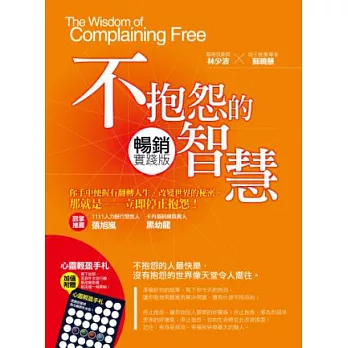close
隱喻與認知 好書推薦

隱喻與認知人氣蠻不錯的,是本不錯的語言學習﹐剛出版的時候我就已經在看了
好書隱喻與認知
看完有一種說不出的感動,內容的每一個細節卻都切合我心意,真的不錯,內容精彩!
語言學習隱喻與認知全書的內容大意
最新與最多的語言學習,博客來每日都有特價商品推薦是網路書店購書最佳選擇!
博客來網路書店歡迎您,博客來,博客來網路書店,博客來網路書局,博客來書店,
商品訊息功能:
長期以來,隱喻只被認為是一種譬喻法,一種文學上的修辭技巧,然而這樣的想法,在仔細觀察生活週遭的語言使用後,很快就會被推翻。隱喻其實並不只是為潤飾而存在,它大量的存在於人類言談及思想中;我們習以為常的語言,其實反映了人類如何了解自己的語言與經驗。
隱喻是人類概念系統的一部分,許多我們思考的方式,我們所經驗的事物都是隱喻的某一種表徵;我們思考以及了解這個世界的方式,其實在某個層面上受到了限制,只是我們往往無所覺。本課程以日常生活的語言現象為基礎,藉由探索「隱喻」的本質與應用,帶領讀者一探人類思維模式的靈活運用,探索思想認知之奧秘,以及文化對人類思維模式的影響。
課程簡介
一、課程名稱:隱喻與認知
二、所屬領域:人文
三、學分數:2
四、任課教師:蘇以文
五、課程說明:
(一)本課程開授目的:本計畫擬透過開設通識課程的方式,以跨學科思考的方式帶領學生研討此經典之內容。本計畫擬由日常生活的語言現象為基礎,逐步帶領學生,進入人類思維模式及認知科學的世界。在1980所出版的Metaphors We Live By, Lakoff and Johnson為認知語言學的研究奠定了里程碑。我們希望藉此能使學生瞭解隱喻及思想的本質,及瞭解其在語言學及認知科學其他研究領域中的角色;使學生能瞭解語言及思想的譬喻性,及文化對人類思維模式的影響及互動關係。
(二)本課程共列11個講授單元,每一講授單元包括下列各項:
1. 講授內容摘要
2. 閱讀作業及思考問題
3. 參考讀物
4. 參考英語語料
六、教材:
Lakoff, G. and M. Johnson 1980. Metaphors We Live By. Chicago: University of Chicago Press.
七、課程進度
第一講?隱喻與思維的本質
Ch1Concepts We Live By
Ch2The Systematicity of Metaphorical Concepts
Ch3Metaphorical Systematicity: Highlighting and Hiding
第二講?概念的方位性與文化思維
Ch4Orientational Metaphors
Ch5Metaphor and Cultural Coherence
第三講對實體的感知與思維
Ch6 Ontological Metaphors
Ch7 Personification
Ch8 Metonymy
第四講概念系統的一致性
Ch9 Challenges to Metaphorical Coherence
Ch10? Some Further Examples
Ch11? The Partial Nature of Metaphorical Structuring
第五講結構性隱喻、譬喻性思維、一般性思維及其經驗基礎
Ch12How Is Our Conceptual System Grounded?
Ch13The Grounding of Structural Metaphors
Ch14Causation: Partly Emergent and Partly Metaphorical
第六講概念性隱喻、思維建構及經驗整體性
Ch15The Coherent Structuring of Experience
Ch16Metaphorical Coherence
Ch17Complex Coherence across Metaphors
第七講概念結構及基礎理論
Ch18Some Consequences for Theories of Conceptual Structure
第八講隱喻、思維與意義
Ch19Definition and Understanding
Ch20How Metaphor Can Give Meaning to Form
Ch21New Meaning
第九講意義與真實
Ch22The Creation of Similarity
Ch23Metaphor, Truth, and Action
Ch24Truth
第十講語言:客觀還是主觀?
Ch25The Myths of Objectivism and Subjectivism
Ch26The Myth of Objectivism in Western Philosophy and Linguistics
Ch27How Metaphor Reveals the Limitations of the Myth of Objectivism
Ch28Some Inadequacies of the Myth of Subjectivism
第十一講結語:語言與思維的經驗基礎
Ch29The Experientialist Alternative: Giving New Meaning to the Old Myths
Ch30Understanding
八? 基本參考書
Lakoff, G. and M. Johnson 1980. Metaphors We Live By. Chicago: University of Chicago Press.
九? 課外閱讀參考書目
.Ahrens, Kathleen. 2001. When love is not digested: Underlying reasons for source to target domain pairing in the Contemporary Theory of Metaphor. In the Proceedings of the First Cognitive Linguistics Conference, Cheng-Chi University, Taiwan.
.Black, Max. 1962. Models and Metaphors. Ithaca, N.Y.: Cornell University Press.
.Bolinger, Dwight. 1977. Meaning and Form. London: Longman.
.Borkin, Ann. 1985. Problems in Form and Function. Norwood, NJ: Ablex.
.Bybee, Joan. 1985. Morphology. Amsterdam: John Benjamins.
.Cienki, Alan (1999). Metaphors and cultural models as profiles and bases. In Raymond W. Gibbs, Jr., and Gerard J. Steen (eds.), Metaphor in Cognitive Linguistics: Selected Papers from the Fifth International Cognitive Linguistics Conference, 189-203. Amsterdam/Philadelphia.
.Cooper, William E., and John Robert Ross. 1975. World order. In Robin E. Grossman, L. James San, and Timothy J. Vance, (eds.), Functionalism. Chicago: Chicago Linguistic Society.
.Dahl, Oyvind. 1995. When the future comes from behind: Malagasy and other time concepts and some consequences for communication. International Journal of Intercultural Relations 19:2, 197-210.
.Davidson, Donald. 1978. What metaphors mean. Critical Inquiry 5:1, 31-47.
.Frege, Gottlob. 1966. On Sense and Reference. In P. Geach and M. Black, (eds.), Translation from the Philosophical Writings of Gottlob Frege. Oxford: Balckwell.
.Gallagher, Shaun. 1995. Body schema and intentionality. In Jose Bermedez, Noami Eilan, Anthony Marcel (eds.), The Body and the Self, 225-244. Cambridge, MA: MIT Press.
.Grice, H. P. 1957. Meaning. Philosophical Review 66:377-88.
.Hill, Clifford A. 1982. Up/down, front/back, left/right: A constrastive study of Hausa and English In J. Weissenbord and W. Klein (eds.), Here and There: Cross-linguistic Studies on Deixis and Demonstration, 13-42. Amsterdam: John Benjamins.
.Jackendoff, Ray S. 1983. Semantics and Cognition-Chapter 1: Semantic Structure and Conceptual Structure. Cambridge, MA: MIT press, 3-22.
.──. 1990. Semantic Structures-Chapter 1: Overview of Conceptual Semantics. Cambridge: MIT Press, 7-41.
.Johnson, Mark. 1987. The Body in the Mind: The Bodily Basis of Meaning, Imagination, and Reason. Chicago: University of Chicago Press.
.Klein, Harriet. 1987. The future precedes the past: Time in Toba In Word, vol. 38:3.
.Koffka, Kurt. 1935. Principles of Gestalt Psychology. London: Lund Humphries.
.Kovecses, Zoltan. 1986. Metaphors of Anger, Pride, and Love. A Lexical Approach to the Structure of Concepts. Amsterdam: John Benjamins.
.──. 1990. Emotion Concepts. Berlin: Springer-Verlag.
.Lakoff, George. 1972. Linguistics and Natural Logic. In Donald Davidson and Gilbert Harman, (eds.), Semantics of Natural Language. Dordrecht: D. Reidel.
.──. 1987. Women, Fire and Dangerous Things. Chicago:? University of Chicago Press.
.──. 1990. The Invariance Hypothesis: Is Abstract Reason Based on Image-Schemase Cognitive Linguistics 1:1, 39-74.
.──. 1993. The Contemporary Theory of Metaphor. In A. Ortony, (ed.), Metaphor and Thought. 2nd. ed. Cambridge: Cambridge University Press.
.──. 1996. Moral Politics: What Conservatives Know That Liberals Don't. Chicago: University of Chicago Press.
.Lakoff, George, and Mark Johnson. 1981. The metaphorical structure of the human conceptual system. In D.A. Norman, (ed.), Perspectives on Cognitive Science, 193-206. Norwood, NJ: Ablex.
.Lakoff, George, and Mark Johnson. 1999. Philosophy in the Flesh: The Embodied Mind and Its Challenge to Western Thought. New York: Basic Books.
.Lakoff, George and Mark Turner. 1989. More than Cool Reason: A Field Guide to Poetic Metaphors. Chicago: Chicago Press.
.Lakoff, George, and Rafael Nueez. 2000. Where Mathematics Comes From: How the Embodied Mind Brings Mathematics into Being. New York: Basic Books.
.Montague, Richard. 1974. Formal Philosophy. New Haven: Yale University Press.
.Richards, I. A. 1936. The Philosophy of Rhetoric. London: Oxford University Press.
.Rosch, Eleanor. 1977. Human categorization. In N. Warren, (ed.), Advances in Cross-cultural Psychology. New York: Academic Press.
.Su, Lily I-wen. 1999a. To “run” a marriage: Conceptualization of marriage in current Chinese. AISB’99 Workshop on Metaphor, Artificial Intelligence & Cognition. Edinburgh University.
.──. 1999b. Thought as food: Conceptual metaphors? in Chinese. Working Papers in Linguistic, Vol. 2 (Dec 1999), 199-224. National Taiwan University.
.──.? 1999c. Metaphorical extension and lexical meaning. The 13th Pacific Asia Conference on Language, Information, and Computation. Taipei.
.──. 2002a. What can metaphor tell us about culture?”Language and Linguistics 3(3): 589-614, Taipei: Academia Sinica.
.── . 2002b. What can metaphor tell us about conceptuali- zation and culture? Proceedings of the Symposium on Selected NSC Projects on General Linguistics 1998-2000. National Taiwan University, Taipei.
.Turner, Mark. 1987. Death Is the Mother of Beauty: Mind, Metaphor, Criticism. Chicago: University of Chicago Press.
.──. 1996. The Literary Mind. New York: Oxford University Press.
.Vosniadou, Stella. and Andrew. Ortony. 1989. Similarity and analogical reasoning: A synthesis. In Stella Vosniadon and Andrew Ortony, (eds.), Similarity and Analogical Reasoning. Cambridge: Cambridge University Press.
.Yu, Ning. 2001. What does our face mean to use Pragmatics & Cognition 9:1, 1–36.
.Yu, Ning. 2002. Body and emotion: Body parts in Chinese expression of emotion. In Nick Enfield and Anna Wierzbicka (eds.) The Body in Description of Emotion: Cross-Linguistic Studies, special issue of Pragmatics and Cognition 10(1/2): 341–367
作者簡介
蘇以文教授
乃夏威夷大學語言學博士,現任國立臺灣大學語言學研究所教授。目前的研究重點為言談分析、語用學及認知語言學,尤重人類思維在語言現象中的體現及其與文化之間的相關性。
內容來自YAHOO新聞
柯文哲慰問員警 (圖)
 |

隱喻與認知人氣蠻不錯的,是本不錯的語言學習﹐剛出版的時候我就已經在看了
好書隱喻與認知
作者: 蘇以文
新功能介紹- 出版社:國立臺灣大學出版中心
新功能介紹 - 出版日期:2005/03/10
- 語言:繁體中文
看完有一種說不出的感動,內容的每一個細節卻都切合我心意,真的不錯,內容精彩!
語言學習隱喻與認知全書的內容大意
最新與最多的語言學習,博客來每日都有特價商品推薦是網路書店購書最佳選擇!
博客來網路書店歡迎您,博客來,博客來網路書店,博客來網路書局,博客來書店,
商品訊息功能:
長期以來,隱喻只被認為是一種譬喻法,一種文學上的修辭技巧,然而這樣的想法,在仔細觀察生活週遭的語言使用後,很快就會被推翻。隱喻其實並不只是為潤飾而存在,它大量的存在於人類言談及思想中;我們習以為常的語言,其實反映了人類如何了解自己的語言與經驗。
隱喻是人類概念系統的一部分,許多我們思考的方式,我們所經驗的事物都是隱喻的某一種表徵;我們思考以及了解這個世界的方式,其實在某個層面上受到了限制,只是我們往往無所覺。本課程以日常生活的語言現象為基礎,藉由探索「隱喻」的本質與應用,帶領讀者一探人類思維模式的靈活運用,探索思想認知之奧秘,以及文化對人類思維模式的影響。
課程簡介
一、課程名稱:隱喻與認知
二、所屬領域:人文
三、學分數:2
四、任課教師:蘇以文
五、課程說明:
(一)本課程開授目的:本計畫擬透過開設通識課程的方式,以跨學科思考的方式帶領學生研討此經典之內容。本計畫擬由日常生活的語言現象為基礎,逐步帶領學生,進入人類思維模式及認知科學的世界。在1980所出版的Metaphors We Live By, Lakoff and Johnson為認知語言學的研究奠定了里程碑。我們希望藉此能使學生瞭解隱喻及思想的本質,及瞭解其在語言學及認知科學其他研究領域中的角色;使學生能瞭解語言及思想的譬喻性,及文化對人類思維模式的影響及互動關係。
(二)本課程共列11個講授單元,每一講授單元包括下列各項:
1. 講授內容摘要
2. 閱讀作業及思考問題
3. 參考讀物
4. 參考英語語料
六、教材:
Lakoff, G. and M. Johnson 1980. Metaphors We Live By. Chicago: University of Chicago Press.
七、課程進度
第一講?隱喻與思維的本質
Ch1Concepts We Live By
Ch2The Systematicity of Metaphorical Concepts
Ch3Metaphorical Systematicity: Highlighting and Hiding
第二講?概念的方位性與文化思維
Ch4Orientational Metaphors
Ch5Metaphor and Cultural Coherence
第三講對實體的感知與思維
Ch6 Ontological Metaphors
Ch7 Personification
Ch8 Metonymy
第四講概念系統的一致性
Ch9 Challenges to Metaphorical Coherence
Ch10? Some Further Examples
Ch11? The Partial Nature of Metaphorical Structuring
第五講結構性隱喻、譬喻性思維、一般性思維及其經驗基礎
Ch12How Is Our Conceptual System Grounded?
Ch13The Grounding of Structural Metaphors
Ch14Causation: Partly Emergent and Partly Metaphorical
第六講概念性隱喻、思維建構及經驗整體性
Ch15The Coherent Structuring of Experience
Ch16Metaphorical Coherence
Ch17Complex Coherence across Metaphors
第七講概念結構及基礎理論
Ch18Some Consequences for Theories of Conceptual Structure
第八講隱喻、思維與意義
Ch19Definition and Understanding
Ch20How Metaphor Can Give Meaning to Form
Ch21New Meaning
第九講意義與真實
Ch22The Creation of Similarity
Ch23Metaphor, Truth, and Action
Ch24Truth
第十講語言:客觀還是主觀?
Ch25The Myths of Objectivism and Subjectivism
Ch26The Myth of Objectivism in Western Philosophy and Linguistics
Ch27How Metaphor Reveals the Limitations of the Myth of Objectivism
Ch28Some Inadequacies of the Myth of Subjectivism
第十一講結語:語言與思維的經驗基礎
Ch29The Experientialist Alternative: Giving New Meaning to the Old Myths
Ch30Understanding
八? 基本參考書
Lakoff, G. and M. Johnson 1980. Metaphors We Live By. Chicago: University of Chicago Press.
九? 課外閱讀參考書目
.Ahrens, Kathleen. 2001. When love is not digested: Underlying reasons for source to target domain pairing in the Contemporary Theory of Metaphor. In the Proceedings of the First Cognitive Linguistics Conference, Cheng-Chi University, Taiwan.
.Black, Max. 1962. Models and Metaphors. Ithaca, N.Y.: Cornell University Press.
.Bolinger, Dwight. 1977. Meaning and Form. London: Longman.
.Borkin, Ann. 1985. Problems in Form and Function. Norwood, NJ: Ablex.
.Bybee, Joan. 1985. Morphology. Amsterdam: John Benjamins.
.Cienki, Alan (1999). Metaphors and cultural models as profiles and bases. In Raymond W. Gibbs, Jr., and Gerard J. Steen (eds.), Metaphor in Cognitive Linguistics: Selected Papers from the Fifth International Cognitive Linguistics Conference, 189-203. Amsterdam/Philadelphia.
.Cooper, William E., and John Robert Ross. 1975. World order. In Robin E. Grossman, L. James San, and Timothy J. Vance, (eds.), Functionalism. Chicago: Chicago Linguistic Society.
.Dahl, Oyvind. 1995. When the future comes from behind: Malagasy and other time concepts and some consequences for communication. International Journal of Intercultural Relations 19:2, 197-210.
.Davidson, Donald. 1978. What metaphors mean. Critical Inquiry 5:1, 31-47.
.Frege, Gottlob. 1966. On Sense and Reference. In P. Geach and M. Black, (eds.), Translation from the Philosophical Writings of Gottlob Frege. Oxford: Balckwell.
.Gallagher, Shaun. 1995. Body schema and intentionality. In Jose Bermedez, Noami Eilan, Anthony Marcel (eds.), The Body and the Self, 225-244. Cambridge, MA: MIT Press.
.Grice, H. P. 1957. Meaning. Philosophical Review 66:377-88.
.Hill, Clifford A. 1982. Up/down, front/back, left/right: A constrastive study of Hausa and English In J. Weissenbord and W. Klein (eds.), Here and There: Cross-linguistic Studies on Deixis and Demonstration, 13-42. Amsterdam: John Benjamins.
.Jackendoff, Ray S. 1983. Semantics and Cognition-Chapter 1: Semantic Structure and Conceptual Structure. Cambridge, MA: MIT press, 3-22.
.──. 1990. Semantic Structures-Chapter 1: Overview of Conceptual Semantics. Cambridge: MIT Press, 7-41.
.Johnson, Mark. 1987. The Body in the Mind: The Bodily Basis of Meaning, Imagination, and Reason. Chicago: University of Chicago Press.
.Klein, Harriet. 1987. The future precedes the past: Time in Toba In Word, vol. 38:3.
.Koffka, Kurt. 1935. Principles of Gestalt Psychology. London: Lund Humphries.
.Kovecses, Zoltan. 1986. Metaphors of Anger, Pride, and Love. A Lexical Approach to the Structure of Concepts. Amsterdam: John Benjamins.
.──. 1990. Emotion Concepts. Berlin: Springer-Verlag.
.Lakoff, George. 1972. Linguistics and Natural Logic. In Donald Davidson and Gilbert Harman, (eds.), Semantics of Natural Language. Dordrecht: D. Reidel.
.──. 1987. Women, Fire and Dangerous Things. Chicago:? University of Chicago Press.
.──. 1990. The Invariance Hypothesis: Is Abstract Reason Based on Image-Schemase Cognitive Linguistics 1:1, 39-74.
.──. 1993. The Contemporary Theory of Metaphor. In A. Ortony, (ed.), Metaphor and Thought. 2nd. ed. Cambridge: Cambridge University Press.
.──. 1996. Moral Politics: What Conservatives Know That Liberals Don't. Chicago: University of Chicago Press.
.Lakoff, George, and Mark Johnson. 1981. The metaphorical structure of the human conceptual system. In D.A. Norman, (ed.), Perspectives on Cognitive Science, 193-206. Norwood, NJ: Ablex.
.Lakoff, George, and Mark Johnson. 1999. Philosophy in the Flesh: The Embodied Mind and Its Challenge to Western Thought. New York: Basic Books.
.Lakoff, George and Mark Turner. 1989. More than Cool Reason: A Field Guide to Poetic Metaphors. Chicago: Chicago Press.
.Lakoff, George, and Rafael Nueez. 2000. Where Mathematics Comes From: How the Embodied Mind Brings Mathematics into Being. New York: Basic Books.
.Montague, Richard. 1974. Formal Philosophy. New Haven: Yale University Press.
.Richards, I. A. 1936. The Philosophy of Rhetoric. London: Oxford University Press.
.Rosch, Eleanor. 1977. Human categorization. In N. Warren, (ed.), Advances in Cross-cultural Psychology. New York: Academic Press.
.Su, Lily I-wen. 1999a. To “run” a marriage: Conceptualization of marriage in current Chinese. AISB’99 Workshop on Metaphor, Artificial Intelligence & Cognition. Edinburgh University.
.──. 1999b. Thought as food: Conceptual metaphors? in Chinese. Working Papers in Linguistic, Vol. 2 (Dec 1999), 199-224. National Taiwan University.
.──.? 1999c. Metaphorical extension and lexical meaning. The 13th Pacific Asia Conference on Language, Information, and Computation. Taipei.
.──. 2002a. What can metaphor tell us about culture?”Language and Linguistics 3(3): 589-614, Taipei: Academia Sinica.
.── . 2002b. What can metaphor tell us about conceptuali- zation and culture? Proceedings of the Symposium on Selected NSC Projects on General Linguistics 1998-2000. National Taiwan University, Taipei.
.Turner, Mark. 1987. Death Is the Mother of Beauty: Mind, Metaphor, Criticism. Chicago: University of Chicago Press.
.──. 1996. The Literary Mind. New York: Oxford University Press.
.Vosniadou, Stella. and Andrew. Ortony. 1989. Similarity and analogical reasoning: A synthesis. In Stella Vosniadon and Andrew Ortony, (eds.), Similarity and Analogical Reasoning. Cambridge: Cambridge University Press.
.Yu, Ning. 2001. What does our face mean to use Pragmatics & Cognition 9:1, 1–36.
.Yu, Ning. 2002. Body and emotion: Body parts in Chinese expression of emotion. In Nick Enfield and Anna Wierzbicka (eds.) The Body in Description of Emotion: Cross-Linguistic Studies, special issue of Pragmatics and Cognition 10(1/2): 341–367
作者簡介
蘇以文教授
乃夏威夷大學語言學博士,現任國立臺灣大學語言學研究所教授。目前的研究重點為言談分析、語用學及認知語言學,尤重人類思維在語言現象中的體現及其與文化之間的相關性。
寬恕是療癒的開始 | 不抓狂的情緒控制術 | ||
焦慮是戒得掉的:不再自己嚇自己的四個練習 | 成功人士都愛玩的EQ測驗遊戲 | ||
不為小事抓狂的50個練習:大腦決定你的「度量」,增加「腦容量」,脾氣一定會變好! | 不生氣的技術 | ||
不抱怨的智慧(暢銷實踐版)(附贈心靈輕盈手札) | 怒火Don’t燒 |
作者: 蘇以文
新功能介紹- 出版社:國立臺灣大學出版中心
新功能介紹 - 出版日期:2005/03/10
- 語言:繁體中文
隱喻與認知
小習慣,決定你要哪一種人生:行為科學改變千萬人的好命法則 | 早上1分鐘的習慣,改變你的人生 | ||
2個字的祝福:每年為自己找到完美新字詞,就能達成新目標! | 給40歲的嶄新開始 博客來  | ||
給大一外甥的40封信:一起聊聊學校不會教的事 | 改變人生的29個練習:真正的渴望,應該是從內心自然湧現的,強求來的就算到手了,也不會覺得幸福。 | ||
20幾歲的智慧:我不懂人生,只想樂活 | 30歲,美極了!-走過懵懂,最漂亮的年紀,正要開始。 |
內容來自YAHOO新聞
柯文哲慰問員警 (圖)
台北市長柯文哲(右2)31日下午探望在教育部抗議的反課綱學生,並到教育部大門慰問員警。中央社記者張皓安攝 104年7月31日
■ 新聞專輯╱課綱微調掀爭議
文章標籤
全站熱搜


 留言列表
留言列表


